In 1812, Napoleon Bonaparte launched one of history's largest military campaigns, invading Russia with the formidable “Grande Armée” comprising around half a million men. However, this massive force met a catastrophic fate during its retreat from Moscow, succumbing to the brutal Russian winter, starvation, and widespread disease. Historians estimate that roughly 300,000 soldiers perished in this harrowing withdrawal, marking it as one of the most devastating military disasters in history. While severe weather and logistical failures have long been recognized as key factors in the army’s collapse, recent scientific discoveries suggest that disease played a more complex and deadly role than previously understood.
For decades, scholars have debated the exact causes behind Napoleon’s loss in Russia, with disease often cited as a major contributing factor. Early DNA studies and the discovery of body lice on soldiers’ remains have pointed to typhus and trench fever as significant afflictions during the campaign. Both diseases are known to thrive in overcrowded and unhygienic conditions, such as those faced by soldiers in the field. Yet the full spectrum of pathogens that struck the Grande Armée has remained elusive, fueling ongoing historical and scientific inquiry.
Rémi Barbieri, a postdoctoral researcher at the Institute of Genomics at the University of Tartu in Estonia, describes the question of why Napoleon lost as “one of the biggest mysteries in history.” To shed new light on this enigma, Barbieri and his colleagues turned to the burgeoning field of ancient DNA analysis, which allows scientists to extract and study genetic material from long-deceased individuals. By sequencing DNA from historical fossils, skeletons, and other ancient remains, researchers can identify pathogens that affected past populations, revealing hidden chapters in human history.
In a groundbreaking study published in the journal Current Biology, Barbieri’s team examined the teeth of 13 Napoleonic soldiers excavated from a mass grave in Vilnius, Lithuania. The site, uncovered in 2002, contained the remains of an estimated 2,000 to 3,000 individuals believed to be soldiers from Napoleon’s ill-fated Russian campaign, supported by artifacts such as buttons and belts found alongside the skeletons. From these remains, the researchers extracted dental pulp—a rich source of preserved DNA—and subjected it to high-throughput sequencing to detect traces of disease-causing bacteria.
The results were surprising. Contrary to expectations, the study did not find genetic evidence of the bacteria responsible for typhus or trench fever, diseases previously linked to Napoleon’s army. Instead, the DNA analysis revealed two other deadly pathogens: Salmonella enterica, which causes paratyphoid fever, and Borrelia recurrentis, a bacterium transmitted by body lice that causes relapsing fever. Both diseases would have been particularly lethal under the harsh conditions of starvation and extreme cold faced by the retreating soldiers.
Nicolás Rascovan, a geneticist and co-author of the study who heads the Microbial Paleogenomics Unit at the Pasteur Institute in France, emphasized that the absence of typhus and trench fever DNA in their samples does not mean these diseases did not affect the army. Rather, the findings highlight a broader spectrum of infectious diseases impacting the soldiers, painting a more complex picture of the health crises that contributed to their downfall. “What [the study] shows is that there was a whole range of diseases that were affecting these people,” Rascovan said.
The study stands out not only for its findings but also for its methodological approach. Barbieri expressed excitement about the new techniques that enabled the identification of pathogens from tiny fragments of ancient DNA, opening avenues to detect diseases that historical records alone could not reveal. “By just reading historical accounts, [it] was impossible to suspect these two pathogens,” he explained, underscoring the power of modern paleogenomics to uncover hidden facets of history.
Experts in the field have praised the rigor and transparency of the study. Marcela Sandoval-Velasco, an assistant professor at the Center for Genome Sciences of the National Autonomous University of Mexico, who specializes in molecular biology to investigate historical questions, commended the researchers for clearly acknowledging the limitations of working with a small sample size—only 13 individuals—while still extracting meaningful conclusions.
The discovery of Salmonella enterica and Borrelia recurrentis in the teeth of Napoleonic soldiers adds new dimensions to our understanding of the health challenges faced by the Grande Armée. Paratyphoid fever, caused

